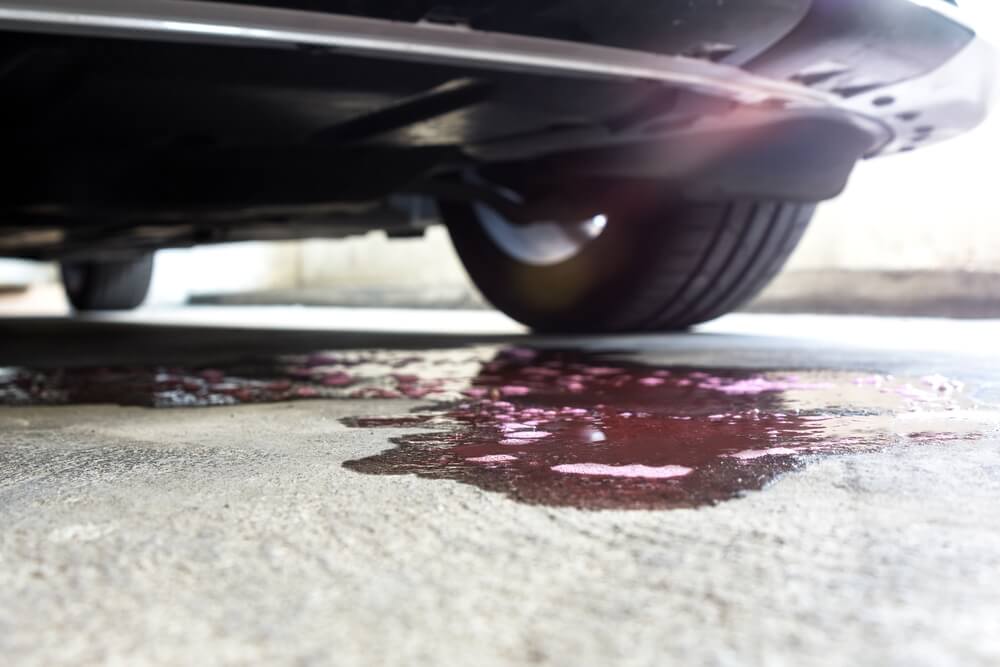Your car’s engine is made of tough materials, but it’s not invincible. It relies on a constant circulation of coolant (also called antifreeze) to keep things running smoothly and prevent overheating.
A leak in this system can have disastrous consequences if not addressed quickly by experts like our mechanics at Kwik Kar. If you find yourself wondering “Do I have a coolant leak?”, here’s everything you ever need to know about coolant leaks and why you should reach out to a Kwik Kar near you if you find one.
What is a Coolant Leak?
A coolant leak occurs when the coolant fluid, typically a mixture of water and antifreeze, escapes from your vehicle’s cooling system. We’ll get into the various causes in a second, but first, lets review the cooling system that leaks impact!
- Radiator: The biggest component, your radiator cools the hot coolant from your engine.
- Hoses: Rubber tubes carry the coolant around your engine.
- Water Pump: The coolant keeps circulating thanks to the water pump.
- Head Gasket: A seal between the engine block and cylinder head that can fail and allow coolant to leak, internally or externally.
If any of these parts of your system develop a leak, your vehicle runs the risk of overheating. Don’t let a coolant leak leave you with a smoking engine.
How Do Coolant Leaks Happen?
Think of your car’s coolant system as an essential network that’s under constant pressure. Things can go wrong with….
Age and Wear
The rubber hoses in your cooling system are subject to constant heat, vibration, and chemicals in the coolant itself. With time, they lose flexibility, get brittle, and can develop small cracks or splits. Think of it like an old rubber band that eventually loses its stretch.
We recommend replacing your rubber hoses once every four years. Beyond that, you’re just asking for a leak.
Corrosion
While coolant has anti-corrosion properties, its protection isn’t absolute. Over the years, internal corrosion within metal parts like the radiator can develop, eventually leading to pinhole leaks or cracks where the metal thins out.
Damage
It doesn’t always take years for a leak to happen. A rock flung from the road, a minor fender bender, or even an animal strike can puncture your radiator or sever a hose.
Improper Maintenance
Sometimes, well-intentioned but inexperienced DIY maintenance creates leaks. Overtightening a hose clamp can put too much pressure on its connection. A faulty radiator cap that fails to regulate system pressure correctly can stress out seals or weak spots that eventually give way.
Do I Have a Coolant Leak?
Don’t ignore these red flags! They could be signs of a potential coolant leak.
Visible Puddles
Look for bright green, orange, or even pinkish puddles underneath your car after it’s been parked for a while.
Coolant manufacturers use these colors to help you distinguish it from regular water or other fluids. Puddles in green orange or pink indicate you have a coolant leak.
Sweet Smell
Ethylene glycol, the main ingredient in most coolants, has a distinctly sweet odor.
If you catch whiffs of this smell, especially after driving, you probably have a coolant leak. Have your coolant system inspected — you might have a heated-up leak that evaporates before it drips.
Temperature Gauge
Your dashboard warning lights and temperature gauge are direct indicators of the health of your cooling system. If your system starts reading consistently hotter or fluctuates into the red “danger” zone, your engine is likely not getting enough coolant.
Empty Reservoir
Your car has a translucent plastic reservoir under the hood for coolant. If the level in this tank is constantly dropping, and you need to top it off frequently, you have a clear sign coolant is escaping the system.
Check Engine Light
Modern cars have sophisticated sensors. In some cases, a serious coolant leak can trigger the “Check Engine” light when the car’s computer detects the engine overheating.
Dangerous Effects of a Coolant Leak
Think of coolant as your car’s lifeline. When it leaks, your engine is in trouble.
Overheating
The primary role of coolant is to absorb heat from your running engine. Lose too much coolant, and temperatures skyrocket. This overstresses everything from delicate sensors to the gaskets that seal your engine together. Continuous overheating will cause catastrophic damage that can lead to…
Cracked Engine Block
The engine block is the heart of your car: a huge chunk of metal. In extreme overheating, the block itself can warp from uneven heat expansion. In the worst case scenario, it outright cracks. This almost always means a total engine replacement, a repair that can cost thousands of dollars.
Seized Engine
Your engine’s internal parts spin smoothly thanks to a film of oil providing lubrication. Excessive heat breaks down this oil and creates friction. Metal-on-metal contact can ultimately lead to parts literally welding themselves together. A seized engine can’t turn at all. The only fix is a rebuild or total replacement.
A slow coolant leak could just shorten the overall life of your engine, but a sudden major leak can lead to a breakdown by the side of the road, an expensive tow — and even irreparable damage, all within just minutes.
Kwik Kar Coolant Leak Repair
At Kwik Kar, we don’t just fix the leak — we get to the bottom of the problem. Here’s our step-by-step approach to radiator and cooling system repair:
1. Diagnosis
Coolant can leak from hidden places. Our technicians don’t just guess, they carefully inspect your car’s entire cooling system. This might include special tools like pressure testers to simulate the forces inside the system when your car is hot, making even small leaks easier to find.
2. Component Replacement
- Hoses: Old, cracked hoses get replaced with durable new ones.
- Clamps: Loose or rusty clamps can be a sneaky culprit, so we address minor issues that might lead to bigger ones.
- Radiators: Sometimes a small radiator leak can be patched to extend its life. However, if the damage is severe, recommending a full replacement is better in the long run.
3. Addressing the Root Cause
A leak is often a symptom of something else getting worn. While fixing the immediate issue, our team looks for signs of other aging components on the verge of failure. We’ll let you know about those concerns so you can make informed decisions, avoiding surprise breakdowns later.
4. System Flush and Refill
Depending on the leak’s severity, contaminants might be in your old coolant. We’ll thoroughly flush out the entire system and refill it with the exact type and mix of fresh coolant that’s recommended for your specific car. This ensures maximum protection and long life for your cooling system.
Kwik Kar Knows Engines
Coolant leaks are sneaky and can escalate quickly.
It’s tempting to ignore a small drip under your car, or just keep adding coolant… but don’t! Early and professional attention is critical to protecting your engine and saving money from more expensive repairs down the road.
Next time you wonder “Do I have a coolant leak?” don’t take any chances! Get an expert diagnosis and fix the problem fast with the techs you trust, only at Kwik Kar.



